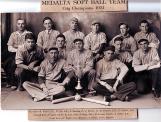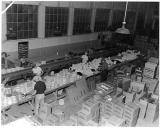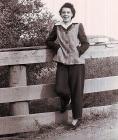2
Rose Woyciehouski is not a household name. It does not appear in any Canadian history books but, in her own small way, she has literally left her mark on a piece of the past in South Eastern Alberta.3
Medalta Softball Team 193120th Century, Circa 1931
Medicine Hat, Alberta, Canada
 Credits:
Credits:Medicine Hat News, Medicine Hat, Alberta, Canada
4
Rose was born Rose Marie Stickle on March 30, 1928. Her father, Christof Stickle, immigrated with his family to Canada from Romania in 1911 when he was 11 years of age. Her mother, Martha Heckenliable, came from Goodrich, North Dakota in 1905. They met and married in Medicine Hat.Chris started working at Medalta Potteries when he was in his early twenties. Like most immigrants, he was not afraid of hard work. In the fall, when the pottery was slow, he would supplement his income by working on a local farm. Over the years, he worked his way up to become supervisor of the packing and shipping department. Throughout his life, he was never without a job of some kind. When the Medalta plant closed, he went on to work at a local brick plant, Bick's Pickles and several other places before finally retiring at the age of 73.
6
His daughter recalls her childhood as a happy one, surrounded by loving parents, her older brother Bob, and her two sets of grandparents doors away. Although things were not always plentiful, the family never felt poor. There was always food on the table, with fresh vegetables out of their own garden, and a roof over their heads.Rose often spent her spare time drawing and colouring, sometimes copying pictures from magazines and comics, recreating Disney characters like Dumbo, Snow White or Bambi. In Grade Six, she did such a good job of illustrating her Social Studies notes that her teacher, Mr. Davidson, asked if he could keep her book.
7
Elm Street School, Medicine Hat, Alberta, Canada20th Century, Circa 1940's
Medicine Hat, Alberta, Canada
 Credits:
Credits:Esplanade Archives, Medicine Hat, Alberta, Canada
Gainsborough Studio Fonds
8
Rose and Bob attended Elm Street School, directly across the street from their house. After Grade 8, Bob left school and went to work at Medalta with his father. He eventually became head of the slip casting department and stayed on until 1950 when he quit after a difference of opinion with the plant manager, Ed Phillipson. His time at Medalta was broken only by the war when, at the age of 17 years, Bob attempted to enlist in the air force. Because of his colour blindness, he was not accepted but did manage to get into the navy where he served as a cook. When Bob finally left Medalta, he found employment at Suffield, Alberta as a tinsmith.Rose finished Grade 8 at Elm Street and then went on to Alexandra High School where she completed Grade 10. At that point, she suddenly lost all interest in school. She spent the summer working in one of the area's many greenhouses and then she too, like her father and brother before her, began work at Medalta in the fall.
9
Medalta Packing Room20th Century, Circa 1940's
Medalta Potteries Limited, Medicine Hat, Alberta, Canada

10
Her fascination with the potteries originated long before she began to work there. As a child, Rose sometimes accompanied her father to the factory. Impressed by the work of the women in the art department, she thought to herself that that was what she wanted to do when she grew up.Her first job at Medalta was not in the decorating department but with her father in the packing area. There she learned to give the ware its final finishing, smoothing any rough edges with a chipper or on the grinding wheel, before it was packed for shipping. Many a day, she remembers working with hands all bandaged up from cuts.
11
Banded oval ware20th Century, Circa 1940's and 1950's
Medalta Potteries Limited, Medicine Hat, Alberta, Canada
 Credits:
Credits:Friends of Medalta Society Collection
12
In time, she was asked by Tom Hulme if she would like to work in the decorating department, the very place she been so attracted to as a child. She found that she loved it. Tom initially taught her to do banding on the flat wheel which meant painting circular lines of glaze on flat ware. It was Rose who got her friend Enge a job doing banding as well. There was always a lot of breakage at the factory and that was what "the girls" practiced on until they became proficient. Not everyone was able to master the technique.Rose's specialty was painting the oval dishes. At that time, much of Medalta's production was hotel ware and there were hundreds of pieces that needed to be banded daily. Working on oval ware was not an easy task because it was entirely manual. Each day, Rose would begin by wrapping tape thickly around the little finger of her painting hand and put a groove in the tape by rubbing her finger against a hard edge. This groove would act as the steadying guide. With the other hand, she would slowly turn the plate as she applied the colour. Red was a particularly difficult colour. In the kiln, it would blister if applied too thickly and turn pink if applied too thinly.
Often, dinner ware sets such as those for the CPR (Canadian Pacific Railway) included both banded lines of colour and logo-type images. The image - either stencilled or stamped - was applied first. Then the image area was covered with a square of tissue paper to protect it and the banding was added.
One of the primary jobs of the art department was to work up samples. Tom would do the initial work of designing a piece and then have the women apply the pattern. Although Rose loved all aspects of her job, her favourite was adding colour to images that Tom would create as a stencil or stamp. These were often special orders. One example was the Palomino plate - a wide band of yellow around the rim and, in the centre, a palomino horse standing on its hind legs.
13
Prisoners of War Camp, Medicine Hat, Alberta, Canada20th Century, Circa 1942
Medicine Hat, Alberta, Canada
 Credits:
Credits:Eplanade Archives, Medicine Hat, Alberta, Canada
Jerry Glasgo
David J. Carter, author "P.O.W. Behind Canadian Barbed Wire"

